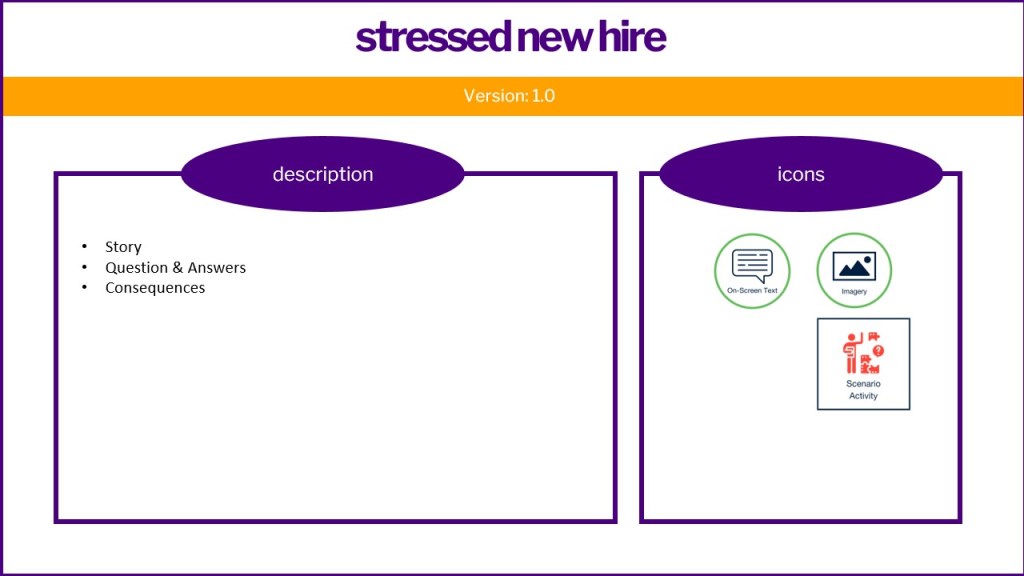
Smashing Induction Training
Overview
This is a scenario-based eLearning concept project designed and developed to help newly appointed Subject Matter Experts (SMEs) in honing their onboarding skills by immersing them in practical learning experiences. Throughout this course, learners will engage in a series of real-life, low-risk scenarios, empowering them to identify and implement effective strategies for seamless onboarding and integration.
audience: Newly Appointed Subject Matter Experts (SMEs) at Horizon Group
responsibilities: Instructional Design, Action Mapping (Needs Analysis), Storyboarding, Visual Design, Mockups, eLearning Development
tools: Articulate Storyline, Vyond, MindMup, Powerpoint
KPI: New Hire’s satisfaction rate with the support received from Subject Matter Experts (SMEs) during the onboarding process will increase by 15% by the end of Q2 as SMEs improve their skills on how to behave in common problematic situations.


process: analysis
I followed the structured steps of the ADDIE model to carefully tweak each stage of my process. This ensured that the learning experience looked, felt, and contained content that met top-notch standards. Before finishing everything up, I created an action map, mapped out a storyboard, designed visual mockups, and built an interactive prototype.
Step 1: Identifying the goal
In the initial phase of developing my onboarding course for Subject Matter Experts (SMEs), I organised a short meeting with the Client to find out their expectations and goals.

Step 2: Specifying the audience and creating learner personas
With the goal of improving new hires’ satisfaction, I identified the onboarding course’s target audience as Subject Matter Experts (SMEs) responsible for facilitation. After researching their roles and challenges, I crafted detailed learner personas, considering job roles, experience levels, and preferences. This tailored approach ensures the course meets SMEs’ diverse needs, enhancing their support for new hires.
Step 3: Identifying the Current State
To assess the onboarding process and SME proficiency levels, the Client and I conducted a thorough evaluation. This included surveys, interviews, and observations to gather insights. Surveys collected perspectives from SMEs and new hires, while interviews delved deeper into SME experiences. Observation provided firsthand insight into SME interactions with new hires. This assessment identified knowledge and skill gaps among SMEs, informing targeted training interventions in the onboarding course.


Step 4: Identifying the Challenge
In another meeting, we gathered the Direct Manager responsible for Onboarding Sessions, SMEs, and NHs who recently underwent onboarding. We reviewed survey, interview, and observation results, discussing current challenges. The main issues identified for SMEs included handling NH stress, confusion, lateness or absence, time constraints, cancelled meetings, and difficult questions.
Step 4: root cause analysis, solutions and people responsible for their implementation
According to Cathy Moore, a seasoned instructional designer, consultant, and author of “Map It,” the primary challenges can be attributed to the following aspects: environment, knowledge, skills and motivation.
During our discussion, we delved into the underlying issues contributing to the challenges faced by SMEs, possible solutions and people responsible for their implementation

As you can see, the course was only a part of the solution. The biggest problem was the lack of proper documentation and support, which we tackled during our analysis phase.
For the next parts, I will focus on the online course only, as this is the part I was responsible for.

process: design
Step 1: scoping
Scoping a project involves defining clear learning objectives and outlining topics and sections.

Step 2: wireframing
The next step is to create wireframing, which involves sketching out the structure and layout of the course content.
Step 3: Screenplanning
Screenplanning involves mapping out the entirety of the course, detailing its core components and providing concise descriptions for each slide or screen. Additionally, icons are employed to signify whether slides incorporate text, audio, video, or images, and denote the type of interaction, if applicable.

Step 4: style guide
A style guide establishes consistent visual and design standards for a project. By following a style guide, designers ensure a unified look and feel, enhancing the overall user experience and brand identity.
Step 5: storyboarding
Storyboarding is the process of visually outlining the narrative flow and structure of a project, typically through sequential images or sketches. It involves mapping out key scenes, interactions, and transitions to provide a visual blueprint for the project’s development.

process: development
Interactive Prototypes and Full Development
Storyboarding and visual mockups lay the groundwork, but it’s the interactive prototype that breathes life into designs. Using Articulate Storyline 360, I created an interactive prototype to gather feedback on functionality and user experience. Incorporating triggers, animations, sound, and a progress meter, I ensured a dynamic user journey. Stakeholder input refined the experience, leading to the addition of a summary section for clear takeaways. Refining the prototype based on feedback is crucial for enhancing the user experience, ensuring the final product meets client and user needs. Once satisfied, I transitioned to full development, refining slides until every element seamlessly meshed. Incorporating user feedback enriched the learning journey, from implementing sound effects to introducing a sound check slide and background music. This development journey has been transformative, enhancing both the product and my skills as a developer.
Additional Features
engaging sound effects: Throughout the experience, carefully chosen sound effects enrich the learner’s immersion, adding realism to their journey. From celebratory sounds during sales victories to affirming tones upon selecting correct answers, each sound serves as positive reinforcement, heightening engagement.
strategic feedback: Introducing mentor character Olivia, learners gain valuable guidance without receiving direct answers. Through the “Ask Olivia” feature, Olivia provides insightful assistance, steering learners towards solutions rather than outright answers, fostering independent problem-solving skills.
immersive scenario-based scenes: Visual storytelling takes center stage, plunging learners into immersive scenarios that vividly depict the consequences of their choices. Rather than passive narration, learners actively experience outcomes, reinforcing learning through firsthand observation.
incorrect choice: Learners witness the repercussions of erroneous decisions, immersing them in scenarios illustrating the adverse effects of aggressive sales tactics. By observing negative outcomes, learners grasp the correlation between certain actions and undesirable consequences, fostering critical thinking.
correct choice: Conversely, learners experience the rewards of making informed decisions, leading to successful outcomes such as sales and positive reviews. By earning five-star ratings, learners progress to view accolades from satisfied customers, reinforcing the value of sound decision-making.
Incorporating these additional features elevates the learning experience, fostering deeper engagement, critical thinking, and skill development among learners.














